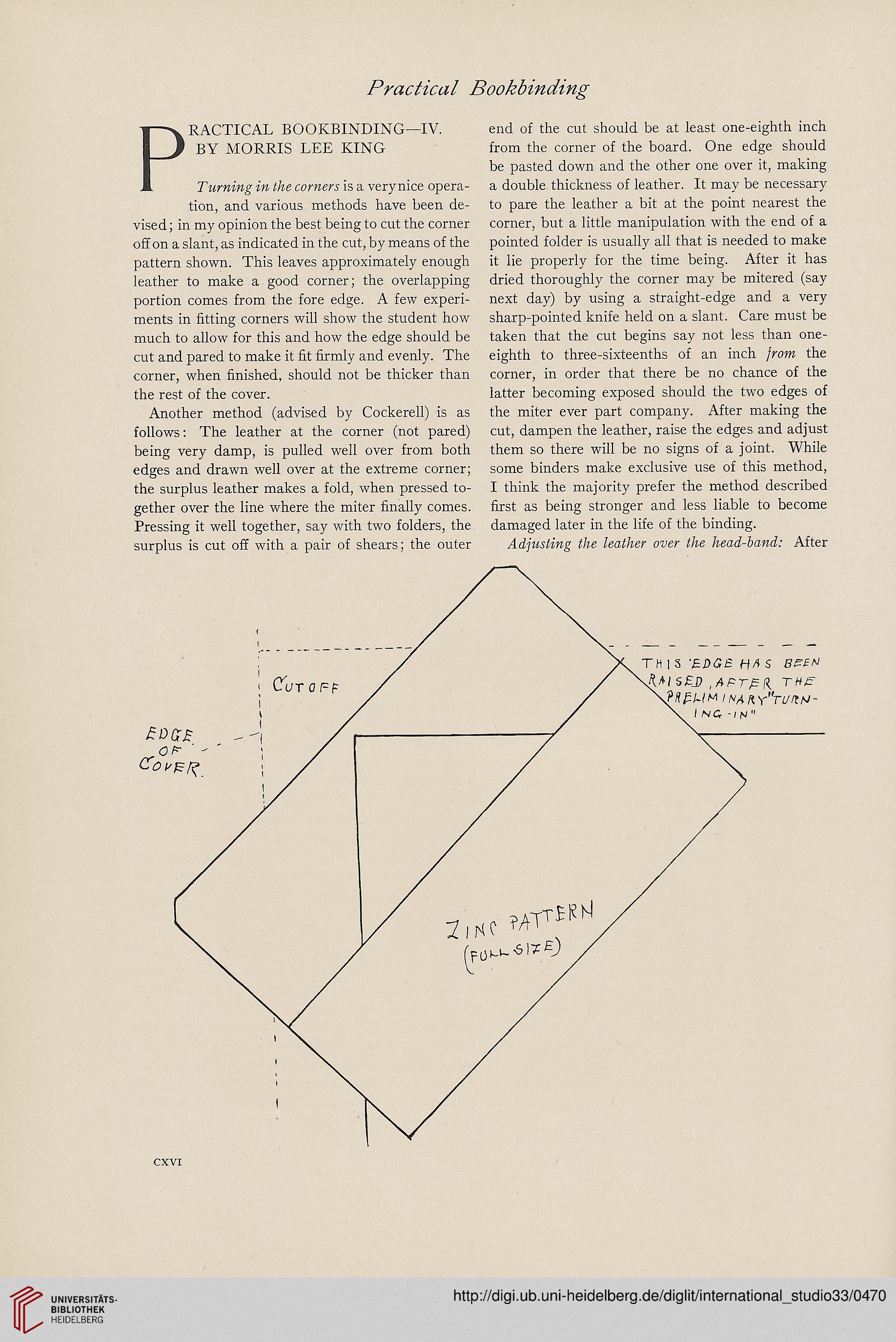Practical Bookbinding
P
RACTICAL BOOKBINDING—IV.
BY MORRIS LEE KING
Tliming in the corners is a verynice opera-
tion, and various methods have been de-
vised; in my opinion the best being to cut the corner
off on a slant, as indicated in the cut, by means of the
pattern shown. This leaves approximately enough
leather to make a good corner; the overlapping
portion comes from the fore edge. A few experi-
ments in fitting corners will show the student how
much to allow for this and how the edge should be
cut and pared to make it fit firmly and evenly. The
corner, when finished, should not be thicker than
the rest of the cover.
Another method (advised by Cockerell) is as
follows: The leather at the corner (not pared)
being very damp, is pulled well over from both
edges and drawn well over at the extreme corner;
the surplus leather makes a fold, when pressed to-
gether over the line where the miter finally comes.
Pressing it well together, say with two folders, the
surplus is cut off with a pair of shears; the outer
end of the cut should be at least one-eighth inch
from the corner of the board. One edge should
be pasted down and the other one over it, making
a double thickness of leather. It may be necessary
to pare the leather a bit at the point nearest the
corner, but a little manipulation with the end of a
pointed folder is usually all that is needed to make
it lie properly for the time being. After it has
dried thoroughly the corner may be mitered (say
next day) by using a straight-edge and a very
sharp-pointed knife held on a slant. Care must be
taken that the cut begins say not less than one-
eighth to three-sixteenths of an inch from the
corner, in order that there be no chance of the
latter becoming exposed should the two edges of
the miter ever part company. After making the
cut, dampen the leather, raise the edges and adjust
them so there will be no signs of a joint. While
some binders make exclusive use of this method,
I think the majority prefer the method described
first as being stronger and less liable to become
damaged later in the life of the binding.
Adjusting the leather over the head-band: After
cxvi
P
RACTICAL BOOKBINDING—IV.
BY MORRIS LEE KING
Tliming in the corners is a verynice opera-
tion, and various methods have been de-
vised; in my opinion the best being to cut the corner
off on a slant, as indicated in the cut, by means of the
pattern shown. This leaves approximately enough
leather to make a good corner; the overlapping
portion comes from the fore edge. A few experi-
ments in fitting corners will show the student how
much to allow for this and how the edge should be
cut and pared to make it fit firmly and evenly. The
corner, when finished, should not be thicker than
the rest of the cover.
Another method (advised by Cockerell) is as
follows: The leather at the corner (not pared)
being very damp, is pulled well over from both
edges and drawn well over at the extreme corner;
the surplus leather makes a fold, when pressed to-
gether over the line where the miter finally comes.
Pressing it well together, say with two folders, the
surplus is cut off with a pair of shears; the outer
end of the cut should be at least one-eighth inch
from the corner of the board. One edge should
be pasted down and the other one over it, making
a double thickness of leather. It may be necessary
to pare the leather a bit at the point nearest the
corner, but a little manipulation with the end of a
pointed folder is usually all that is needed to make
it lie properly for the time being. After it has
dried thoroughly the corner may be mitered (say
next day) by using a straight-edge and a very
sharp-pointed knife held on a slant. Care must be
taken that the cut begins say not less than one-
eighth to three-sixteenths of an inch from the
corner, in order that there be no chance of the
latter becoming exposed should the two edges of
the miter ever part company. After making the
cut, dampen the leather, raise the edges and adjust
them so there will be no signs of a joint. While
some binders make exclusive use of this method,
I think the majority prefer the method described
first as being stronger and less liable to become
damaged later in the life of the binding.
Adjusting the leather over the head-band: After
cxvi





